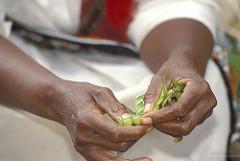Kenyan Farmers to Benefit From Innovative Insurance Program
You are here

NAIROBI, March 12, 2016- The Government of Kenya today launched the Kenya National Agricultural Insurance Program, which is designed to address the challenges that agricultural producers face when there are large production shocks, such as droughts and floods.
The program, which is designed as a partnership between the government and the private sector, was developed with assistance from the World Bank Group and builds on the experience of similar programs in Mexico, India, and China. One program line will focus on livestock insurance, while another will focus on maize and wheat insurance.
“The large majority of the poor in Kenya are farmers, so this program has the potential to have a significant impact on Kenya’s economic development. This program aims at improving farmers’ financial resilience to these shocks and will enable them to adopt improved production processes to help break the poverty cycle of low investment and low returns,” says Diarietou Gaye, World Bank Country Director for Kenya.
For livestock, drought represents the single greatest cause of livestock mortality in the Northern Arid and Semi-Arid Lands. Through the new Kenya Livestock Insurance Program (KLIP), the government will purchase drought insurance from private insurance companies on behalf of vulnerable pastoralists. Satellite data is used to estimate the availability of pasture on the ground and triggers payouts to pastoralists when availability falls. KLIP was introduced in October 2015 for 5,000 pastoralists in Turkana and Wajir and is envisaged to be scaled across the region by 2017.
For maize and wheat, production shocks such as droughts and diseases pose similar challenges to producers. These risks also diminish banks’ appetites to lend to farmers to improve their farming technology and productivity. The Kenya Agricultural Insurance and Risk Management Program, introduced today, addresses these challenges through an “area yield” approach: Farming areas are divided up into insurance units – if average production in one of the units falls below a threshold, all insured farmers in the unit receive a payout. The program is starting up in Bungoma, Embu, and Nakuru this month and plans to reach 33 counties by 2020.
”This partnership between government and the private sector for the benefit of vulnerable farmers builds on international good practice and is innovative,” says Olivier Mahul, Program Manager of the Disaster Risk Financing and Insurance Program at the World Bank. “The program introduces a state-of-the-art method of collecting crop yield data, using statistical sampling methods, GPS-tracking devices, and mobile phones. This offers the promise of greater accuracy and transparency. This program could pave the way for other large scale agricultural insurance programs in Africa.”
This program will also help the Government of Kenya reduce the financial burden of natural disasters. From 2005 to 2011, the government estimates that it spent on average more than Kshs 7 billion per year on disaster relief. By enabling better financial protection for the most vulnerable, the government hopes to reduce its need to provide financial support following natural disasters.
The technical assistance provided by the World Bank Group has been led by the Disaster Risk Financing and Insurance Program (DRFIP), with funding from the Netherlands Ministry of Foreign Affairs and the United States Agency for International Development, and the Global Index Insurance Facility (GIIF), a multi-donor trust fund managed by the World Bank Group, with funding from the European Union, Japan and The Netherlands.
